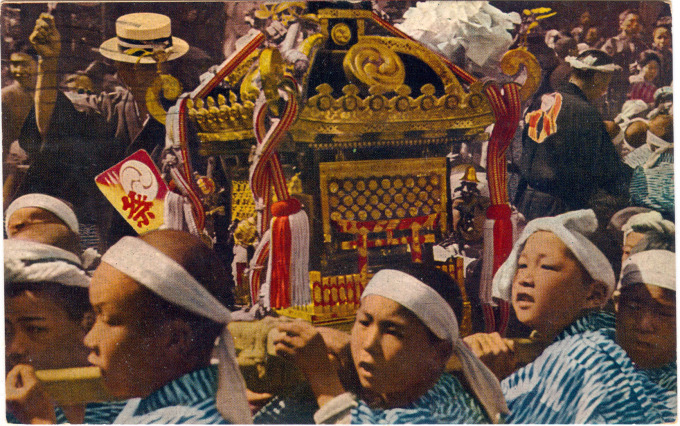“Standing in a pile of lacy shavings and grinning, Tokuji Ai admits it was purely by chance that he became a miyashi. ‘My father was a farmer and I was his second son, so I had to take up some sort of craft.’ His work consists of handsome lacquered mikoshi (the ‘palanquin of the gods’), outdoor shrines, wooden decorations and shrines for wedding halls, and the kamidana that preside in the high corner of almost every house in Japan.
“… Mr. Ai hands me a shaving to inspect. It’s of Japanese cypress, the main and only material along with the tougher Zelkova tree that is used to make the body of the shrines. ‘It takes about a year to make a large mikoshi,’ Mr. Ai continues.
“‘Orders are usually made in the fall, after the large festivals. Mr. Hosoda and I can make about two or three a year. But it’s not just us, the kijiya (wood workers), there are other artisans involved: the chokinya (decorative metal workers), the urushiya (lacquer workers), and the hakuya (goldbeaters).”
– Vanishing Japan: Traditions, Crafts & Culture, Elizabeth Kiritani, 1995
“A mikoshi is a divine palanquin (also translated as portable Shinto shrine). Shinto followers believe that it serves as the vehicle to transport a deity in Japan while moving between main shrine and temporary shrine during a festival or when moving to a new shrine. Often, the mikoshi resembles a miniature building, with pillars, walls, a roof, a veranda and a railing.
“The first recorded use of today’s palanquin-like structure was in the transfer of a Kyushu shrine deity and sacred texts to Nara where they were used to safeguard the construction of the Great Buddha image at Todaiji temple in 749 CE.
“During a matsuri [Japanese festival] involving a mikoshi, people wearing festival clothing bear the mikoshi on their shoulders by means of two or four (or sometimes, rarely, six) poles. They bring the mikoshi from the shrine, raucously carrying it around the neighborhoods that worship at the shrine, and in many cases leave it in a designated area, resting on blocks called uma [horse], for a time before returning it to the shrine.
“The mikoshi is sometimes carried about with a bouncy flourish called the mikoshi furi, a shaking of the palanquin which is said to show the turbuluent character of the deity enshrined within.
“The most typical way of shouldering the mikoshi is termed hira-katsugi, where bearers walk at normal pace without shaking the mikoshi while calling out, ‘Wasshoi! Wasshoi!‘.
“In Tokyo-to (metropolitan area), the mikoshi is sometimes shouldered in the Edomae-katsugi style while calling out, ‘Soiya! Seiya!‘. But, even within Tokyo-to, in the Shinagawa Ward area, they shoulder the mikoshi in a distinctive Jonan-katsugi style. Shrine bearers move the mikoshi to simulate the heave of the ocean while shouting ‘Choi! Choi!‘.”
– Wikipedia



Pingback: Jidai Matsuri, Kyoto, 1914. | Old Tokyo